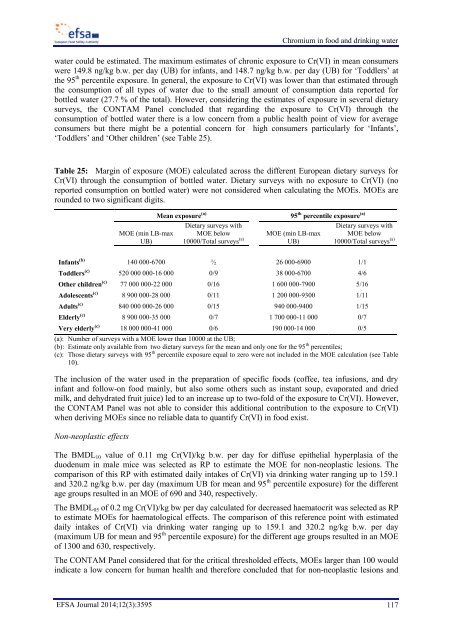efsa-opinion-chromium-food-drinking-water
efsa-opinion-chromium-food-drinking-water
efsa-opinion-chromium-food-drinking-water
Create successful ePaper yourself
Turn your PDF publications into a flip-book with our unique Google optimized e-Paper software.
Chromium in <strong>food</strong> and <strong>drinking</strong> <strong>water</strong><br />
<strong>water</strong> could be estimated. The maximum estimates of chronic exposure to Cr(VI) in mean consumers<br />
were 149.8 ng/kg b.w. per day (UB) for infants, and 148.7 ng/kg b.w. per day (UB) for ‘Toddlers’ at<br />
the 95 th percentile exposure. In general, the exposure to Cr(VI) was lower than that estimated through<br />
the consumption of all types of <strong>water</strong> due to the small amount of consumption data reported for<br />
bottled <strong>water</strong> (27.7 % of the total). However, considering the estimates of exposure in several dietary<br />
surveys, the CONTAM Panel concluded that regarding the exposure to Cr(VI) through the<br />
consumption of bottled <strong>water</strong> there is a low concern from a public health point of view for average<br />
consumers but there might be a potential concern for high consumers particularly for ‘Infants’,<br />
‘Toddlers’ and ‘Other children’ (see Table 25).<br />
Table 25: Margin of exposure (MOE) calculated across the different European dietary surveys for<br />
Cr(VI) through the consumption of bottled <strong>water</strong>. Dietary surveys with no exposure to Cr(VI) (no<br />
reported consumption on bottled <strong>water</strong>) were not considered when calculating the MOEs. MOEs are<br />
rounded to two significant digits.<br />
MOE (min LB-max<br />
UB)<br />
Mean exposure (a) 95 th percentile exposure (a)<br />
Dietary surveys with<br />
MOE below<br />
10000/Total surveys (a)<br />
MOE (min LB-max<br />
UB)<br />
Dietary surveys with<br />
MOE below<br />
10000/Total surveys (a)<br />
Infants (b) 140 000-6700 ½ 26 000-6900 1/1<br />
Toddlers (c) 520 000 000-16 000 0/9 38 000-6700 4/6<br />
Other children (c) 77 000 000-22 000 0/16 1 600 000-7900 5/16<br />
Adolescents (c) 8 900 000-28 000 0/11 1 200 000-9300 1/11<br />
Adults (c) 840 000 000-26 000 0/15 940 000-9400 1/15<br />
Elderly (c) 8 900 000-35 000 0/7 1 700 000-11 000 0/7<br />
Very elderly (c) 18 000 000-41 000 0/6 190 000-14 000 0/5<br />
(a): Number of surveys with a MOE lower than 10000 at the UB;<br />
(b): Estimate only available from two dietary surveys for the mean and only one for the 95 th percentiles;<br />
(c): Those dietary surveys with 95 th percentile exposure equal to zero were not included in the MOE calculation (see Table<br />
10).<br />
The inclusion of the <strong>water</strong> used in the preparation of specific <strong>food</strong>s (coffee, tea infusions, and dry<br />
infant and follow-on <strong>food</strong> mainly, but also some others such as instant soup, evaporated and dried<br />
milk, and dehydrated fruit juice) led to an increase up to two-fold of the exposure to Cr(VI). However,<br />
the CONTAM Panel was not able to consider this additional contribution to the exposure to Cr(VI)<br />
when deriving MOEs since no reliable data to quantify Cr(VI) in <strong>food</strong> exist.<br />
Non-neoplastic effects<br />
The BMDL 10 value of 0.11 mg Cr(VI)/kg b.w. per day for diffuse epithelial hyperplasia of the<br />
duodenum in male mice was selected as RP to estimate the MOE for non-neoplastic lesions. The<br />
comparison of this RP with estimated daily intakes of Cr(VI) via <strong>drinking</strong> <strong>water</strong> ranging up to 159.1<br />
and 320.2 ng/kg b.w. per day (maximum UB for mean and 95 th percentile exposure) for the different<br />
age groups resulted in an MOE of 690 and 340, respectively.<br />
The BMDL 05 of 0.2 mg Cr(VI)/kg bw per day calculated for decreased haematocrit was selected as RP<br />
to estimate MOEs for haematological effects. The comparison of this reference point with estimated<br />
daily intakes of Cr(VI) via <strong>drinking</strong> <strong>water</strong> ranging up to 159.1 and 320.2 ng/kg b.w. per day<br />
(maximum UB for mean and 95 th percentile exposure) for the different age groups resulted in an MOE<br />
of 1300 and 630, respectively.<br />
The CONTAM Panel considered that for the critical thresholded effects, MOEs larger than 100 would<br />
indicate a low concern for human health and therefore concluded that for non-neoplastic lesions and<br />
EFSA Journal 2014;12(3):3595 117



